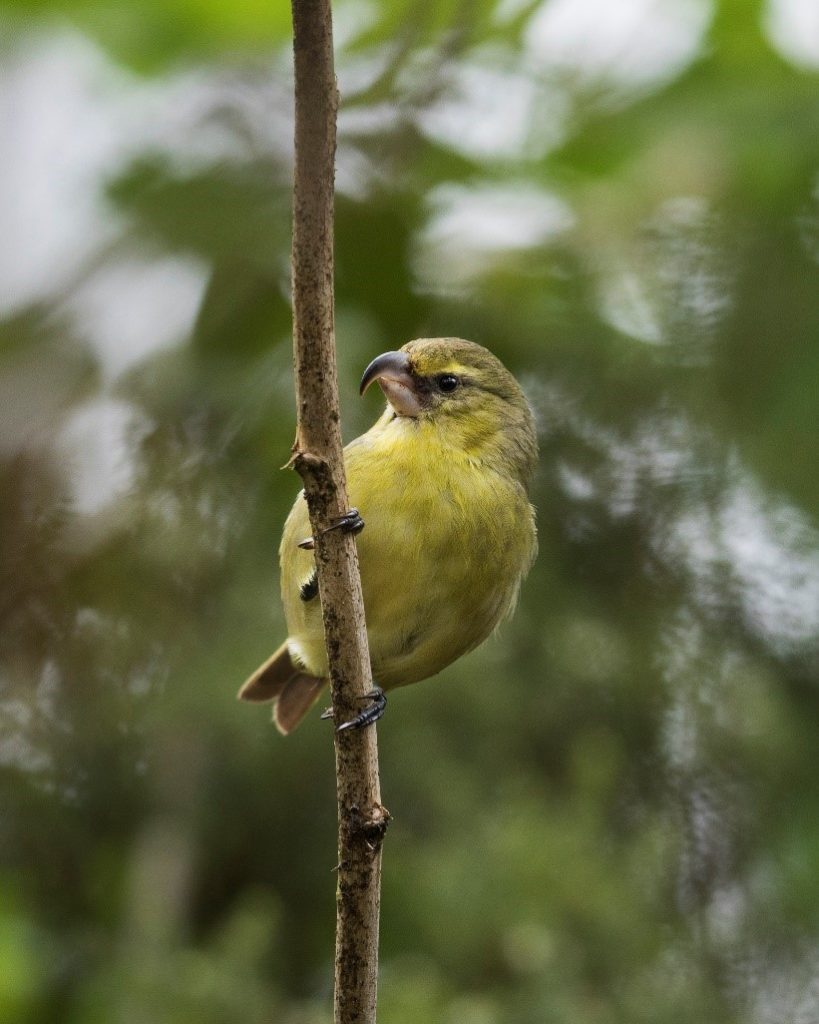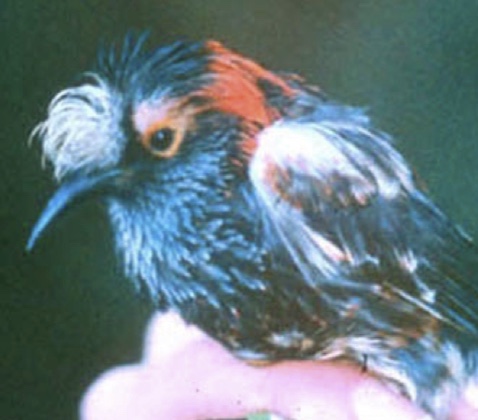“It is a very dire situation. We have some strategies, and we’re pursuing them as fast as possible on parallel tracks, but it’s a lot of fingers crossed right now,” Department of Land and Natural Resources director Suzanne Case told her fellow members of the Board of Land and Natural Resources last month.
At the board’s March 25 meeting, the DLNR’s Division of Forestry and Wildlife briefed the board on its plan to rescue between 20 and 30 critically endangered kiwikiu (Maui parrotbill) from their shrinking habitat and ensconce them at three mainland facilities until they can be released in a location safe from avian malaria-carrying mosquitoes.
Models have predicted that the west and east populations of the tiny honeycreepers will be functionally extinct in 2021 and 2026, respectively, according to state forest bird biologist Lainie Berry. The population is considered functionally extinct once it shrinks to 10 breeding pairs.
The bird’s population was relatively stable between 1980 and 2001, with 400 to 500 individuals, but has plummeted since then. At last count, in 2017, there were an estimated 157 kiwikiu left in the wild. Berry said there is a concern that that trend has continued and there are now fewer than 157 left.
In October 2019, hoping to establish a new population on the island, the state translocated seven birds from the Hanawi Natural Area Reserve (NAR) and seven captive birds to the Nakula NAR. While they thrived initially, most of them quickly succumbed to avian malaria.
The Nakula NAR was believed to be safe from the disease, but since the release, additional surveys indicate there had been a drastic increase in mosquitos. During the 2019 release, there could have been a seasonal spike in the population – either that, or the high infiltration is the new normal at Nakula, Berry said.
In any case, the kiwikiu are highly vulnerable in their current habitat. Research has shown that the “mosquito zone” moves seasonally, Berry said, adding that changes in precipitation patterns are “creating a climate more amenable to mosquitoes and avian malaria transmission. … The problem is getting steadily worse every year and we are running out of time.”
Over the last few decades, kiwikiu have moved further upslope. “We’re only finding them at the highest distributions now. … If we get these ‘king tides’ of mosquito influxes upslope, it doesn’t take much to infiltrate the kiwikiu habitat,” she said.
A working group in 2020 found that the most important thing to do to prevent the species’ extinction was to safeguard a portion of the population in captivity until a safe relocation site can be found. Right now, that doesn’t exist on Maui, she said.
In the past, the San Diego Zoo has housed populations of the species, but it had limited success in captive breeding and now has no capacity for a new batch of kiwikiu, Berry said. The zoo already has its hands full caring for and rearing critically endangered ʻalala (Hawaiian crow) and Kauaʻi ʻakikiki and ʻakekeʻe (both honeycreepers).
Removing 30 kiwikiu will mean the birds will go extinct in the wild sooner than estimated, by about three years, she said. “But at the same time, it would give us something we don’t have: a safe population that will be protected from avian malaria. … We feel it would be worth the risk,” she continued.
The National Aviary in Pennsylvania, the Smithsonian Conservation Biology Institute in Virginia, and the Tracy Aviary in Utah have all committed to taking the birds on. Right now, they have a combined capacity for 20 individuals. “We feel 20 individuals is not enough. We want to get at least 30 — 15 breeding pairs,” she said.
The plan will be to capture the birds, hold them for a very short time in Hawaiʻi, then transport them to the mainland zoos as quickly as possible, she said.
In the meantime, the state is exploring the possibility of eventually translocating the birds to Hawaiʻi island, which she said may have more disease-free habitat than Maui. “We don’t know yet if this is a viable option,” she said, noting that potential impacts the kiwikiu might have on Hawaiʻi island birds, and vice versa, need to be evaluated.
Another project critical to the long-term viability of the species is the development of landscape-scale mosquito control.
Without landscape-scale mosquito control, Berry said, “we are going to lose not just the kiwikiu, but many other Hawaiian bird species.”
Efforts are already underway to introduce male Culex mosquitoes that host a strain of the naturally occurring Wolbhchia bacteria that is different than the one found in Hawaiʻi. According to Berry, mating male and female mosquitoes must have matching strains of Wolbachia bacteria to produce viable eggs. If male Hawaiian mosquitoes with a unique strain can be reintroduced, they’ll mate with wild females and will suppress the population, she said.
“This is being used around the world to target human diseases and it is being used on the U.S. mainland. We completed the transfer of Hawaiʻi mosquitoes to the mainland,” she said.
She expects the DLNR will obtain a permit this year from the Hawaiʻi Department of Agriculture to import them back into Hawaiʻi. It will also apply for an emergency permit from the Environmental Protection Agency to do a pilot release.
She said if the state can get that emergency permit, a pilot release can happen next year. After further EPA approval of a biopesticide registration, a landscape-scale release could occur in 2024, according to her timeline.
Birds in a Bucket
“Your timeline for projected extinction and things that need to happen … It’s too tight,” board member Kaiwi Yoon said.
Berry said the functional extinction predictions are just based on models. “We do believe we have time before then. There are still birds in the wild. We know that. We feel like we need to act as soon as possible to get enough birds into captivity to establish a big enough population in captivity we can use to save enough species in the wild,” she said.
Yoon asked about the other bird species that are facing the same fate as the kiwikiu. “It’s not just the kiwikiu. There’s a bunch of birds in this bucket,” Yoon said.
Berry explained that the ʻakikiki and ʻakekeʻe are in danger because they are found in a relatively low-elevation plateau on Kauaʻi. “If we get that inundation of mosquitoes, they have nowhere to go,” she said. She also said Maui’s critically endangered ʻakohekohe (Crested honeycreeper) is also a species of concern.
There are 40 ʻakikiki and about 7 ʻakekeʻe in captivity. “We’re looking for other options for akekeʻe, including potential translocation [to other islands]. … Holding a captive population is not the solution,” she said. She added that the captive ʻakikiki aren’t breeding well, either.
Board member Jimmy Gomes asked how the mainland facilities will create an environment that the island birds can get acclimated to.
Berry said they can create controlled climates, but that providing access to the native Hawaiian foods the birds would get in the wild will be limited. “They’ll do what they can,” she said.
Board member Sam Gon asked how the ʻakohekohe would do in captivity.
Berry replied that it doesn’t do well. “Even transporting the bird is risky. It’s not a viable alternative. We are definitely concerned about that species, as well. … For that species we’re looking at landscape-level mosquito control as the thing that turns that population around,” she said.
“The landscape mosquito control is likely to be the big answer for all our forest birds,” Gon said.
Board member Chris Yuen said there are no guarantees that the proposed plan will work, but the only alternative is to let the kiwikiu go extinct.
To ensure there is high-elevation habitat available that Hawaiian forest birds can migrate to as temperatures warm, Berry said, in addition to the slow natural forest line movement that will likely occur, the state is planting vegetation above the tree line at several locations around the state “to get a head start.”
Yoon asked what funding the state had for these initiatives.
DOFAW administrator Dave Smith said the work depends heavily on federal funds. “This is not just our issue. It’s a federal endangered species issue, as well,” he said.
There are “a whole bunch of irons in the fire” to protect the birds, he said. “We hope we can cobble together the money and people can understand the dire situation they’re in.”
Case noted that the National Park Service is also very engaged in the effort.
“It’s really going to be a team effort to try to pull this off,” Smith said.
— Teresa Dawson
(This article has been amended to correct the spelling of Lainie Berry’s last name.)







Leave a Reply